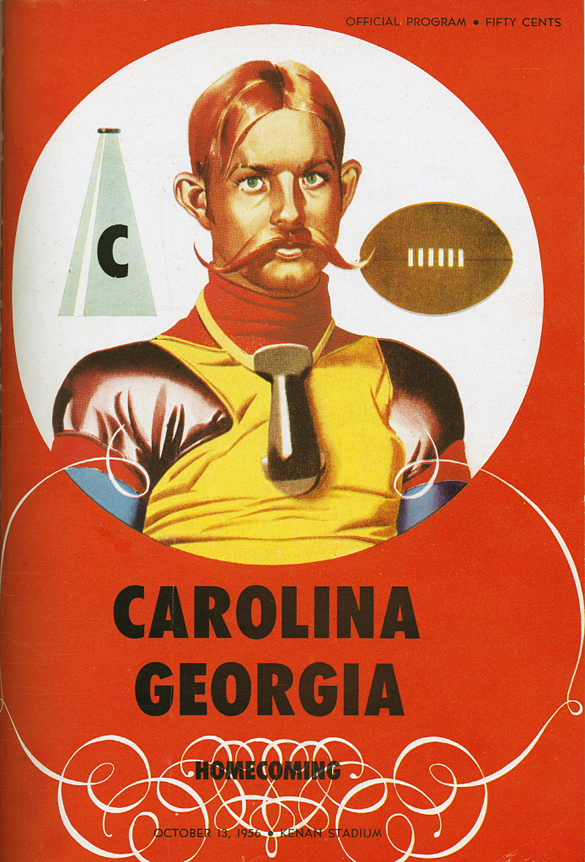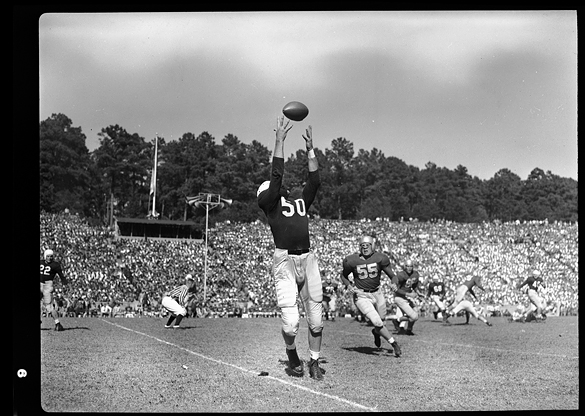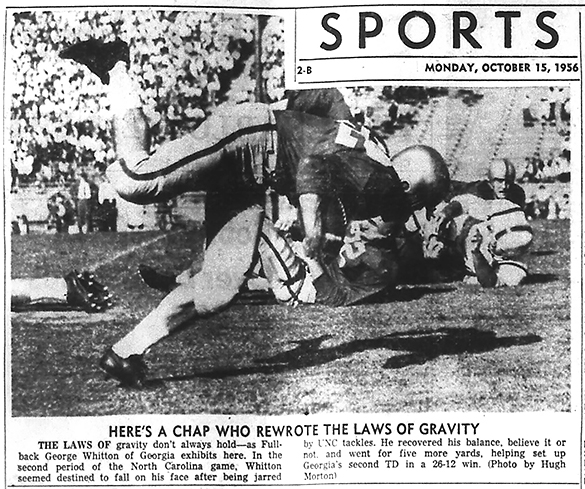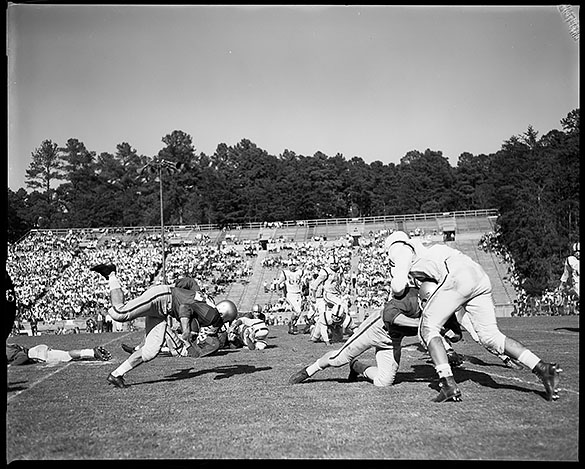UNC will kick off the 2016 football season in Atlanta’s Georgia Dome on September 3rd at 5:30 PM (Eastern) on ESPN. It’s the “Chick-Fil-A Kickoff Game” between Carolina’s Tar Heels and Georgia’s Bulldogs. The game will mark the thirty-first meeting between the two old rivals in a series that dates back to 1895. Morton collection volunteer Jack Hilliard takes a look back at this historic series.

Cover of the official program for the 1956 UNC Homecoming football game against the University of Georgia. Handlebar mustaches would have been more popular in the late 1890s, so perhaps the cover design was a throwback to the early days of the UNC–Georgia series. The 1956 contest marked the silver anniversary between the football squads of what the cover story declared to be the “two oldest state institutions” in the South. Those in the know know which school was the first to open its door and admit students!
When Carolina and Georgia square off in the “Chick-Fil-A Kickoff Game” on September 3rd, it will mark the 7th time the two teams have played in Atlanta. Of the first three games in the series played there, Carolina won two games in 1895 and Georgia won the third game, 24 to 16, on October 31, 1896. In 1898 the two teams played in Macon, Georgia before returning to Atlanta in 1899. In 1900 these foes met in Raleigh, where Carolina won in a rout 55 to 0. Then in 1901 it was back to Atlanta where Carolina shut out the Dogs for a second straight year, this time 27 to 0.
Twelve seasons passed before the two teams met again. The 1913 game was a 19 to 6 Georgia victory at Sanford Field in Athens, Georgia. The sixth and most recent game (until 2016) in Atlanta was played on October 17, 1914—a game the Tar Heels won 41 to 6. There were no games between the two between the years 1915 and 1928.
The teams renewed their series on October 19, 1929 when Georgia visited Chapel Hill for the first time. The game played in Kenan Memorial Stadium turned out to be a tough 19-to-12 loss for the Heels. During the next five seasons, the two teams rotated home and away with Georgia winning in 1930, 1931, and 1933, while Carolina could win only in 1934. The game in 1932 ended in a 6–6 tie.
Once again, twelve seasons played out before the two teams met next, and this was a big one: the 1947 Sugar Bowl in New Orleans. Photographer Hugh Morton planned to attend, but had a last-minute-in-flight change of plans. “I missed the 1947 Sugar Bowl against Georgia,” Morton explained in a 1992 game-day program, because bad flying weather diverted some other Tar Heel rooters and me to St. Petersburg instead of New Orleans.”
Most long-time Tar Heels know the 1947 Sugar Bowl story: Carolina’s first bowl game . . . battle of the “Charlies,” Justice and Trippi . . . controversial call . . . a Georgia victory, 20 to 10. (You can read a longer version of the story via the link.)
On opening day, September 27, 1947, Georgia head coach Wally Butts brought his Bulldogs into Chapel Hill before 43,000 fans for the “rematch” of the Sugar Bowl. I don’t believe the national attention this game brought to Chapel Hill as ever been equaled. Fifty-five reporters filled the press box; photographers, including Hugh Morton, lined the sidelines. Present were all five movie newsreel services (MGM, Warner Bros–Pathe, Fox Movietone, Universal, and Paramount) and five radio networks (ABC, CBS, Atlantic, Tobacco Sports, and the Georgia Sports Network). The networks transmitted the play-by-play via 600 stations. Nationally known sportscasters Harry Wismer from ABC and Red Barber from CBS were on hand. Two Walt Pupa touchdown passes, one to Bob Cox and one to Art Weiner, sealed the 14 to 7 Carolina victory. Hugh Morton’s picture of Weiner from the ’47 Georgia game is a classic and has been reproduced many times over the years. It was Georgia’s first loss in eighteen games over three seasons.

UNC left end Art Weiner catches pass during game against Georgia at Kenan Stadium, September 27, 1947. UNC tailback Charlie Justice (left) looks on from a distance while Georgia’s Dan Edwards (#55) watches from a few yards away.
When Carolina returned to Athens for the 1948 game, Charlie Justice had his best day ever, gaining 304 total yards in a 21 to 14 Tar Heel win.
It was another Art Weiner day in Chapel Hill on October 1, 1949, as the All America end caught two touchdown passes to lead Carolina to a third straight seven-point victory over Georgia—again 21 to 14 to the delight of 44,000 fans in Kenan. In a 1992 interview, Art Weiner described his 33-yard 4th quarter touchdown as one of his proudest moments during his time in Chapel Hill.
On October 7, 1950, it was back to Athens for the 20th meeting between Carolina and Georgia. I have some special memories from this game as I sat at home in Asheboro, North Carolina listening to the play-by-play on the Tobacco Sports Network. Normally the play-by-play announcer would be Ray Reeve, but on this day he was not able to be behind the microphone and my future dear friend and sports anchor at WFMY-TV in Greensboro, Charlie Harville did the broadcast. In the end it was a 0 to 0 tie…the second time for a tie game in the long history of the series.
Festivities for the 1951 Carolina – Georgia game got off to an unusual start. On Friday night, September 28th, a torchlight parade through downtown Chapel Hill and across campus was followed by a pep rally in Memorial Hall that featured both head coaches, Carl Snavely from Carolina and Wally Butts from Georgia. The 1951 Tar Heel football team, led by Captain Joe Dudeck, made a dramatic entrance down the center aisle and onto the stage. In addition to the speeches from the head coaches, Kay Kyser, UNC’s All-Time Cheerleader, led the packed-house in a rousing cheer.
But on Saturday, in Kenan Stadium, it was all Bulldogs, 28 to 16.
The 1952 meeting between Carolina and Georgia was scheduled for October 4th, but two days before, UNC was forced to cancel the game because of a polio outbreak on campus. Georgia Head Coach Wally Butts said, “We are very disappointed that our traditional game with North Carolina can’t be played. We feel they were right to cancel the game under the circumstances.”
Starting with the 1953 game in Athens, the Dogs went on a 4 game winning streak ending with a 26 to 12 win to spoil homecoming in Chapel Hill on October 13, 1956 in front of only 19,000 fans. That ’56 game was the silver anniversary game in the series.

Hugh Morton’s action photograph of the 1956 UNC versus Georgia game, as published in the October 15, 1956 issue of The Charlotte News. The caption identifies the ball carrier as George Whitton, but the game day program does not include his name and lists #32 as Ed Burkhalter.

Hugh Morton’s negative of the above scene, without cropping.
The teams would not meet again until the 1963 season. Going into that season’s game in Chapel Hill on November 2nd, the series stood at twelve wins for Georgia, eleven wins for Carolina, and two ties. After Carolina’s 28 to 7 win the series was tied at twelve. As it turned out, that UNC victory would be its last win over Georgia. The Tar Heels subsequently lost in 1964, ’65, and ’66 as well as the last time these two teams met in the 1971 Gator Bowl—a game that was billed as the “Battle of the Brothers” between Vince Dooley of Georgia and Bill Dooley of Carolina.
That 1971 New Year’s Eve battle in Jacksonville, Florida was UNC’s sixth bowl game appearance going back to the 1947 Sugar Bowl game against Georgia. After a scoreless first half, Carolina took a 3 to 0 lead in the 3rd quarter on a 35-yard field goal by Ken Craven, but Georgia came back later in the third with a 25-yard Jimmy Poulos TD run. Following the point-after, that was all the scoring that day. Georgia won the defensive battle 7 to 3. (Hugh Morton was otherwise preoccupied and did not travel to photograph the bowl game.) Carolina has not played Georgia since that day. Tomorrow’s 2016 season opener will renew the storied rivalry.
